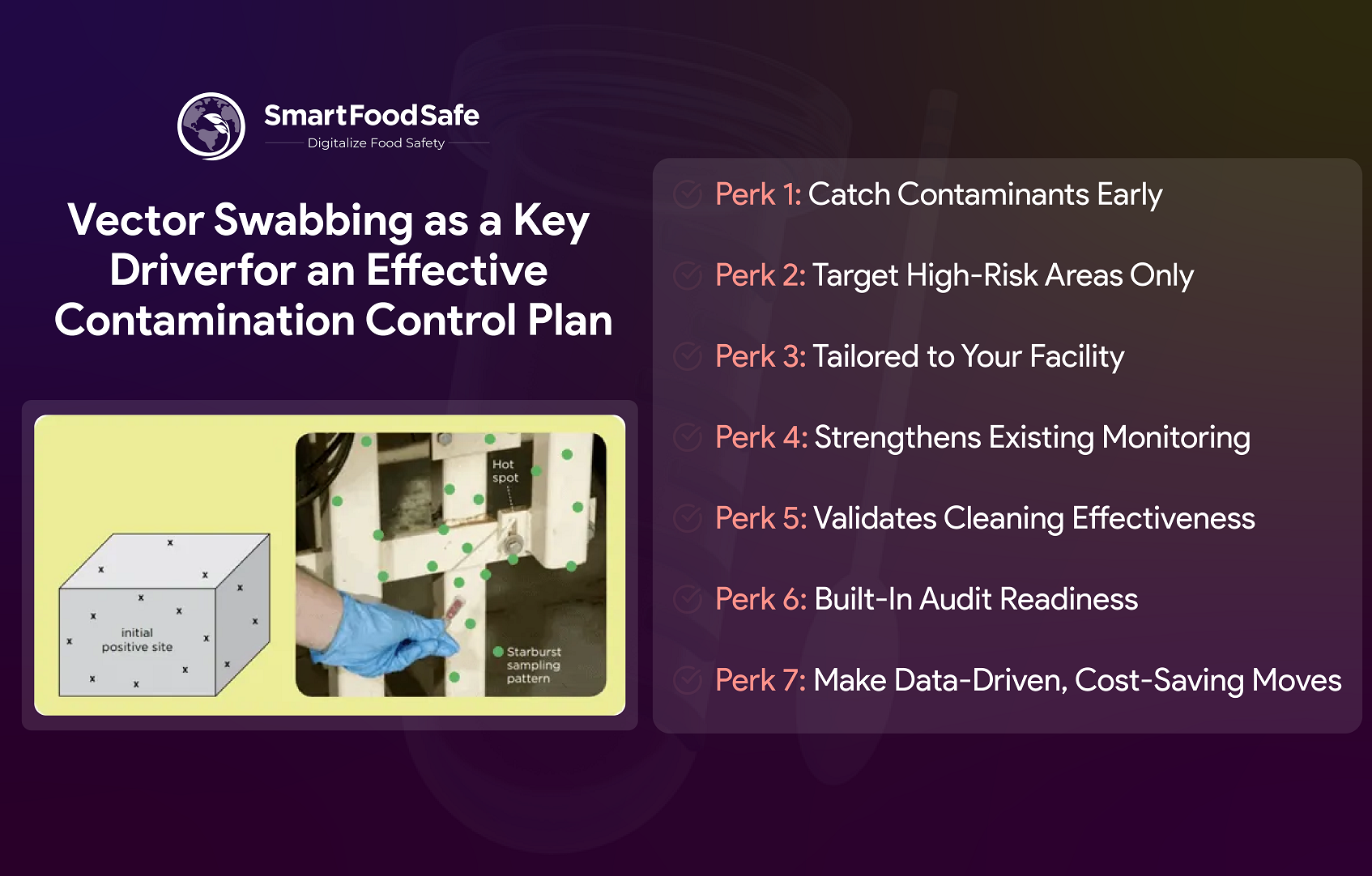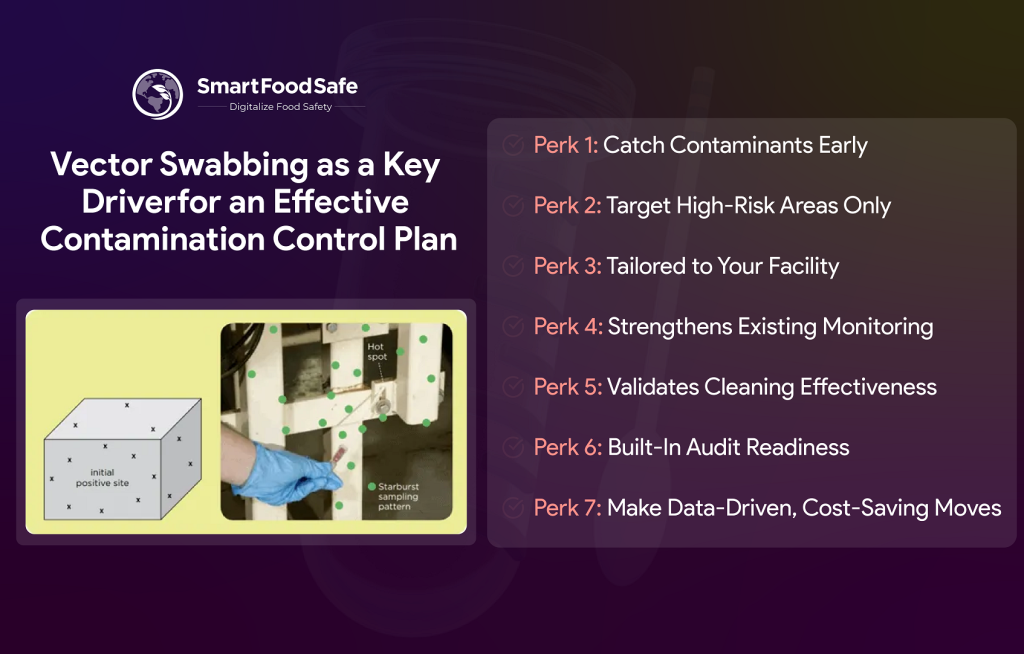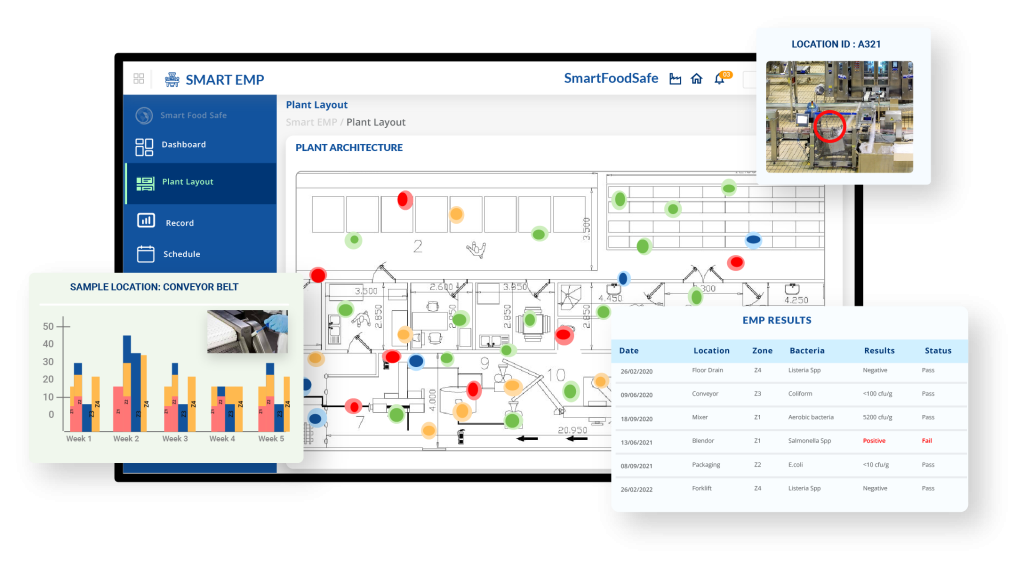
Here is something that can happen to you: You have completed your routine environmental monitoring and are reviewing the trending data from the past few weeks. Everything looks within acceptable limits—until a recent report shows an unexpected spike in microbial levels in a critical zone. Even more concerning, one of the samples indicates a potential pathogen presence.
The immediate question arises: Where did it come from, and how far has it spread? This is where vector swabbing comes into play as a critical next move. You may ask why? Because vector swabbing helps you trace the contamination from its potential source through its possible routes of spread, enabling faster root cause analysis and targeted corrective action.
Industries like food, pharmaceutical, and life sciences operate under strict hygiene and safety standards, where even a single contamination event can have widespread consequences. Understanding and applying vector swabbing is essential for these sectors, as it strengthens their Environmental Monitoring Program (EMP) by ensuring that potential contamination pathways are identified, investigated, and controlled before they escalate into product safety or compliance issues.
Understanding the Concept of Vector Swabbing
Vector swabbing is a targeted environmental monitoring technique used to detect and control contaminants in industrial settings. Unlike general surface sampling, vector swabbing focuses on specific high-risk areas or “vectors”—locations most likely to harbor or spread contaminants—based on risk assessments, process flows, and historical data.
When paired with indicator testing methods like ATP swabs or microbiological assays, vector swabbing offers a swift and cost-efficient way to monitor and mitigate microbial risks before they escalate. These points, or “vectors,” are identified through a risk-based approach, considering factors like:
- Process Flow: Areas where materials, personnel, or equipment intersect, increasing the likelihood of contamination (e.g., filling lines, cleanroom entry points).
- Environmental Conditions: Locations prone to moisture, temperature fluctuations, or poor airflow, which may foster microbial growth.
- Historical Data: Sites with past contamination incidents or near-misses.
- Critical Control Points: Surfaces or equipment directly impacting product quality (e.g., product contact surfaces in a pharmaceutical manufacturing line).
Swabs are typically analyzed using methods like microbial culturing, ATP testing, or PCR to identify the presence and type of contaminants. The “vector” aspect emphasizes prioritizing sampling locations based on their potential to act as pathways for contamination spread, rather than random or blanket sampling.
This method focuses on high-risk transition areas—zones adjacent to critical processing or sterile environments—where contamination is most likely to travel if not intercepted early. By targeting these peripheral zones for regular testing, facilities can catch early signs of microbial movement and take corrective actions before pathogens reach product contact surfaces.
To make the most of vector swabbing, facilities must go beyond surface-level testing and adopt a strategic mindset. This involves interpreting environmental monitoring data through the lens of microbial ecology and contamination patterns. By integrating vector swabbing into a broader Environmental Monitoring Program (EMP), organizations can create a resilient contamination control framework.
Perks of Incorporating a Vector Swabbing Strategy Within Your Environmental Monitoring Program
Vector swabbing is a proactive, data-driven approach to contamination control. The inclusion of one into an environmental monitoring plan enhances contaminant control by aligning with industry best practices and addressing practical needs. Its importance stems from its ability to resolve the following industry challenges:
Perk 1: Early Detection of Contaminants – Contamination often originates or spreads from specific points (e.g., a poorly sanitized valve or a high-traffic cleanroom door handle). Vector swabbing targets these areas, enabling early detection before contaminants proliferate or compromise products.
Perk 2: Risk-Based Efficiency – Blanket environmental monitoring (sampling every surface indiscriminately) is resource-intensive and may miss critical areas. Vector swabbing optimizes resource allocation by focusing on high-risk vectors, improving the efficiency of monitoring programs.
Perk 3: Customized Risk Management – Every facility has unique contamination risks based on its processes, layout, and products. Vector swabbing allows industries to tailor monitoring to their specific vulnerabilities, ensuring comprehensive coverage of critical areas.
Perk 4: Complements Existing Monitoring – Vector swabbing integrates seamlessly with other monitoring methods (e.g., air sampling, water testing) to provide a holistic view of environmental conditions. It fills gaps that passive or random sampling might miss.
Perk 5: Efficacy of Facility Hygiene Practices – Vector swabbing not only acts as a real-time snapshot of environmental hygiene but also functions as an early warning system. Positive results in non-contact zones may indicate process stress, sanitation lapses, or equipment failure—all before they result in compromised product safety.
Perk 6: Demonstrates Due Diligence – During audits, regulators expect evidence of proactive contamination control. A well-documented vector swabbing program showcases a facility’s commitment to quality and compliance through a scientific, targeted approach to contamination control.
Perk 7: Preventing Cross-Contamination – Vectors often act as conduits for cross-contamination between processes, personnel, or products. Swabbing these points helps identify and mitigate risks before they escalate.
Perk 8: Data-Driven Decision Making & Cost Savings – Vector swabbing generates actionable data to trend contamination patterns, validate cleaning procedures, and guide corrective actions. By preventing contamination incidents, vector swabbing reduces the risk of product recalls, production downtime, and regulatory penalties, which can be financially devastating.
What It Takes to Build an Effective Vector Swabbing Plan
Vector swabbing involves the systematic collection of samples from predetermined, high-risk points in a facility using swabs to test for contaminants such as microorganisms, chemical residues, or particulates. The following are the key components to setting up a strong vector swabbing plan:
1. Strategic Sampling Design
A successful vector swabbing plan starts with a smart sampling design. One effective method is to use a starburst pattern, where swabs are collected outward from a contamination point in multiple directions over several days. This helps identify the direction and source of contamination spread.
Another key strategy is dividing the facility into risk-based zones. High-risk areas such as food contact surfaces require more frequent sampling, while lower-risk zones like surrounding walls or equipment may be monitored less frequently. This zone-based approach ensures that efforts are prioritized where the risk is highest.
2. Data Analysis and Interpretation
Once samples are collected, analyzing the microbial load helps identify patterns, such as recurring hotspots or increasing contamination levels. This data isn’t just for detection—it’s also vital for predicting where contamination might occur next.
Using trend analysis or predictive models, facilities can anticipate risks and proactively implement controls before issues escalate.
3. Corrective Actions and Verification
If contaminants are found, immediate corrective action is essential. This includes identifying the root cause—whether it’s equipment malfunction, hygiene lapses, or facility design flaws—and addressing it thoroughly.
After corrective actions, re-swabbing is critical. Repeating the sampling until multiple consecutive negative results are achieved ensures the issue has been resolved and that no residual contamination remains.
The recent times have seen the rise of digital solutions for EMP has transformed how industries manage contamination risks. These tools automate and optimize processes, making EMPs more efficient, accurate, and compliant with regulatory standards. By replacing manual, paper-based EMP processes with centralized digital platforms, facilities can streamline workflows, reduce human error, and enhance the outcomes of the contamination control plan.
A Smarter Way of Performing Your Vector Swabbing Strategy With Smart EMP’s Digital Solution
Smart EMP is an EMP software designed to modernize environmental monitoring programs with a set of focused digital features that attend to the different steps in your EMP, including a well-rounded vector swabbing process.
When traditional, paper-based vector swabbing programs often fall short, plagued by inconsistent schedules, missed sampling points, and fragmented records, Smart EMP tackles these bottlenecks by presenting a smart, data-driven protocol for your environmental monitoring to help you move from a reactive to a proactive process.
Here’s how Smart EMP facilitates the whole process:
-
Digital Plant Layout and Zone Configuration: Users can upload a facility’s floor plan or create one using drag-and-drop tools. The layout includes markers for equipment, drains, traffic flows, and sampling points, categorized by risk-based zones (e.g., Zone 1 for food contact surfaces, Zone 4 for remote areas).
High-risk vectors, such as transition areas or critical control points, are highlighted, ensuring they are prioritized for swabbing.
-
Automated Sampling Schedules: Smart EMP generates fixed or random sampling schedules to ensure comprehensive coverage of vectors. For example, it can prioritize a starburst pattern around a known contamination point or rotate sites to prevent oversight of potential risks.
Notifications (via email, SMS, or in-app alerts) remind staff to collect samples, reducing the likelihood of missed swabs.
-
Systematic Sample Collection: During collection, staff can log results in real-time using mobile devices, with the option to upload images of sampling sites for documentation.
The collected samples are then analyzed either through an internal lab or externally via third-party labs.
-
Integration with Laboratories: Smart EMP supports both in-house and external lab analyses by generating chain-of-custody forms and allowing seamless upload of results via Excel templates.
This ensures that vector swabbing data is accurate and up-to-date.
-
Result Interpretation: The software automatically interprets analytical results as PASS or FAIL based on predefined compliance specifications configured for each test type.
If a non-compliant result (e.g., exceeding microbial limits) is detected, the system triggers a structured corrective action workflow.
-
Non-Compliance Management: As part of this workflow, the platform initiates a vector swabbing procedure to investigate the potential spread of contamination. Users can pinpoint the contamination source and place markers on the uploaded images to target surrounding high-risk areas for additional swabbing. This process includes guided steps for sample collection, analysis, and result interpretation.
The non-compliance case progresses through this workflow until re-swabbing yields a compliant (PASS) result. If non-compliance persists, the corrective action cycle is automatically re-initiated.Throughout the process, the software tracks and logs all activities—including swab results, corrective actions taken, and re-testing—ensuring audit-ready documentation and demonstrating regulatory due diligence.
-
Data Visualization and Trend Analysis: Smart EMP’s heat and harborage maps visually display contamination patterns, highlighting areas with recurring positives or high microbial loads.
This helps teams focus vector swabbing efforts on problem zones. Trend analysis tools predict potential risks based on historical data, allowing proactive adjustments to the swabbing plan.




